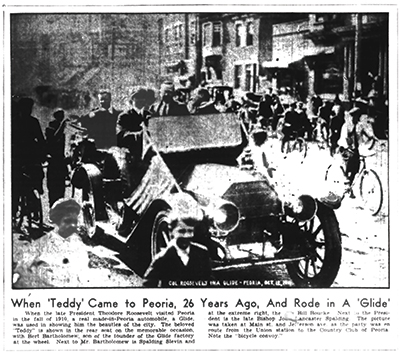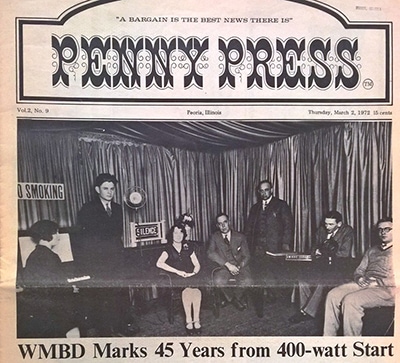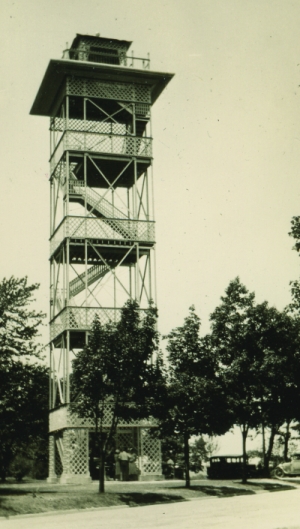From sheeted ghosts and cedar woodpeckers to (one of) the world’s most beautiful drive(s)…
Residents Scared by Strange Spook
For years the Grandview Drive castle was known for its extravagant Halloween goings-on: eerie music, costume-clad “scarers” and lavish indulgences for trick-or-treaters. But decades earlier, nearby residents were "seared almost into their graves" over the nightly presence of a "fearsome apparition which has come unbidden to their side as they were traversing the Drive on their way homeward." From the April 6, 1907 edition of the Peoria Evening Star:
A real ghost sheeted and ghastly whose pale form is so impalpable that through it objects can be distinctly seen skulks by night along its wooded slopes, dodges in and out among trees and fences, and glides silently along in the wake of vehicles that pass that way, frightening the occupants nearly to death by its uncanny presence and mysterious actions.
According to numerous accounts, there were enough sightings of the ghost to make the tale credible and newsworthy. On April 16, 1907, Dr. Frank Baldwin and Charles May, both skeptics, set out to disprove its existence—only to return "convinced they had actually seen a wraith."
The story was debunked some 20-plus years later, writes George Johnson in the Peoria Daily Record, by “a former Averyvillian… high in the councils of government,” who admitted that several boys in the neighborhood, himself included, “had rigged up a white-sheeted figure which they manipulated on a hidden wire over the roadway." So much for the ghost of Grandview Drive…
World’s Most Beautiful Drive?
We all know of Teddy Roosevelt’s visit to Peoria in 1910, when he supposedly proclaimed Grandview the “World’s Most Beautiful Drive,” from which WMBD is said to have taken its call letters. But did TR, an accomplished world traveler, really say that?


“I looked at the Peoria papers’ accounts of Roosevelt’s death in 1919 and there is no mention of his famous quotation,” explains Christopher Farris of the Peoria Public Library Local History and Genealogy Department. “The newspapers that covered the first broadcast from WMBD did not mention the Roosevelt connection either. This led me to look into how the station got its call letters.”
WMBD Radio went on the air in 1927, broadcasting from the home of Enos Kahler near Grandview Drive. Kahler’s living room was the studio; his garage held the transmitter and generator (which he built himself); and the radio tower was in his backyard. As for the call letters, an authoritative account appeared in the Penny Press weekly in 1972:
When [Kahler] applied to the U.S. Department of Commerce for his license to broadcast, he eagerly awaited… the call letters which were to be assigned to him.
"He told me when he left for work that if he got a letter from Washington, I should open it, because he could hardly wait for the news," recalled Mrs. Kahler. "The letter came, and I called him, and I said, 'Hello, WMBD.'" …
"I remember the day well," added [Kahler’s daughter], "and what fun we had trying to put a slogan to the letters. Then someone remembered Teddy Roosevelt's remark about the 'world's most beautiful drive' and it was a natural."
While a 1913 Peoria Park District report does state that Grandview Drive was “recognized as one of the most beautiful in the country,” and Roosevelt indeed remarked on its magnificence, the famous phrase was probably not uttered as such. It seems the slogan—paraphrased and then put to call letters—gave rise to the legend… which continues to this day.
 Tale of Two Towers
Tale of Two Towers
The 200-foot water tower on Prospect Road near Grandview Drive is one of the Peoria area’s most recognizable landmarks. Erected in the late sixties, it’s known for offering spectacular views of the Illinois River Valley, as well as the idiosyncratic touch of a six-foot-tall woodpecker along its side. The cedar carving, created by Canadian chainsaw artist Henry Stadlbauer, was ordered for the tower by philanthropist Bill Rutherford of the Forest Park Foundation, which helped finance the project.
Tower Park was dedicated on September 20, 1970—a ceremony that also marked the unveiling of the bronze bust of Abraham Lincoln, cast from the original mold from Mount Rushmore, which remains a fixture of the park today.
But the current tower wasn’t the first to loom over Grandview Drive. In 1905, a 75-foot observation tower was constructed by A. Lucas & Sons near the intersection of Grandview and Glen Avenue, originally intended as a lookout for forest fires. In 1942, it was razed to provide 100 tons of scrap metal to Allied forces—but local historian Norm Kelly, who recalls watching the tower’s dismantling as a kid, says that may not actually have happened.
“According to the late Merle Yontz [businessman and community leader who lived on Grandview], the steel was never even picked up, nor was it used for the war effort,” Kelly declares. "He knows because… he saw that steel in a scrap yard." The Peoria Park District later spoke of structural damage to the steel, which would explain why it never made its way into U.S. military tanks or ships. Spoiler alert: we won the war anyway… and got a new tower, twice as tall, with an outsized cedar woodpecker to boot! a&s
Follow the Peoria Public Library’s Local History Collection on Facebook @ppllocalhistory for historic photos and rich samplings of local history. For more information, visitpeoriapubliclibrary.org/local-history-and-genealogy.


